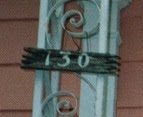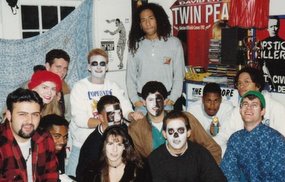During the first decade I spent in Chapel Hill, from 1989 through 1999, the landscape really didn't change all that much. Sure, residential and commercial ("mixed use") developments like Meadowmont and Southern Village got built on the outskirts of town, sapping energy from Franklin Street. And the intersection of Franklin and Columbia would never recover its former mojo after the hole-in-the-wall convenience store Top Of The Hill got replaced by the monstrous, character-less building that houses the restaurant/bar Top Of The Hill and formerly, First Union and Wachovia branches on the first floor. Where I memorably stood mesmerized in front of the bank's big screen TV on December 10, 2000, when the newsflash hit CNN that the Supreme Court had halted the Florida hand recount, two days before handing the stolen election to George W. Bush with their 5-4 decision in Bush v. Gore.
But if you drove downtown circa 1999, things would have looked remarkably similar to how they had ten years before. And this was true of my favorite Chapel Hill avenue Rosemary Street even more so than Franklin. Rosemary's human-scale, low-key, underdeveloped charm was marred only by a multi-story student apartment complex called The Warehouse that sprung up in the late 90s courtesy of guess who, everyone's least favorite next-door neighbor, Larry Short.
As the next decade got underway, things started changing for the worse. Construction started in late 2003 on the towering condo complex that was built where the Lost City used to stand, across from Henry's / Fuse and the Skylight Exchange / Nightlight. Once it was done, the rush was on to build more. Plans were laid for Greenbridge and another Larry Short path to riches, Shortbread Apartments, half of it to be built on the land where the original Breadman's stood before moving across the street in the early 90s.
When Greenbridge finally broke ground in 2008, and construction picked up steam in 2009, it was clear the Rosemary Street landscape would never look the same. I had been out of town for a few weeks that summer and this was probably my first glimpse of the accelerating construction. The rising, hulking structure looked so out of place to me that I had to document the moment.
 Rosemary Street on August 11, 2009.
Rosemary Street on August 11, 2009.
Later, Greenbridge would be plagued by financial troubles, and actually went into foreclusure. Partially because of timing, since the project was completed right before the bottom dropped out of the real estate market thanks to the dawn of the Great Recession. But also because its developers never gave enough thought to the question of whether they might have difficulty attracting rich buyers to live in luxury condos built at the entranceway to Northside. The area that's one of Chapel Hill's only historically black neighborhoods, and still home to lots of working class families, fixed-income elderly residents, and plain ol' poor folks.
(Editor's note from 2013 - Even today, as the development remains half empty, plenty of Greenbridge apologists exist, but the fact is that it was out of character for its surroundings, and a blight on the Rosemary Street landscape. Chapel Hill is steadily being ruined by developers, and Greenbridge was a major signpost along the way.)





































No comments:
Post a Comment